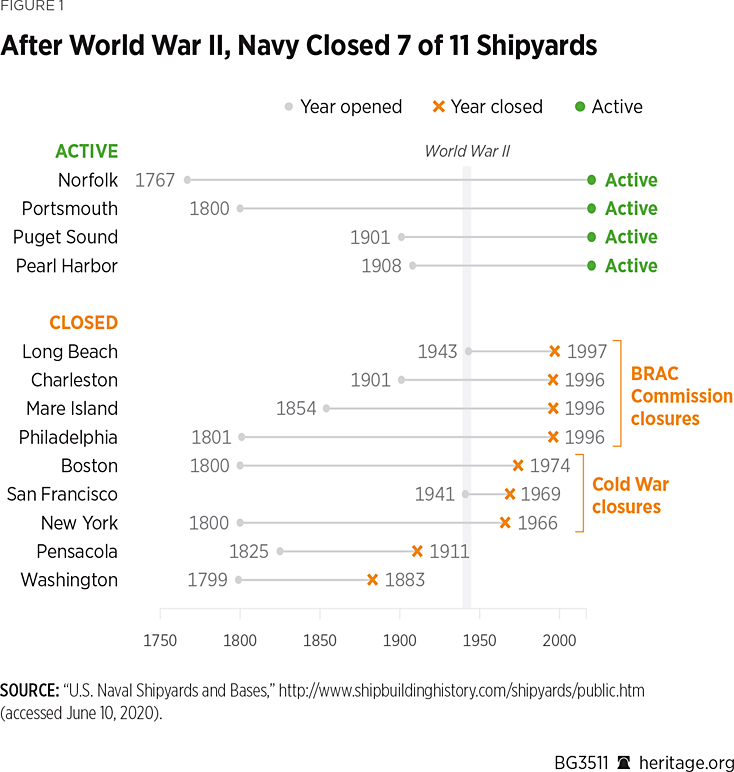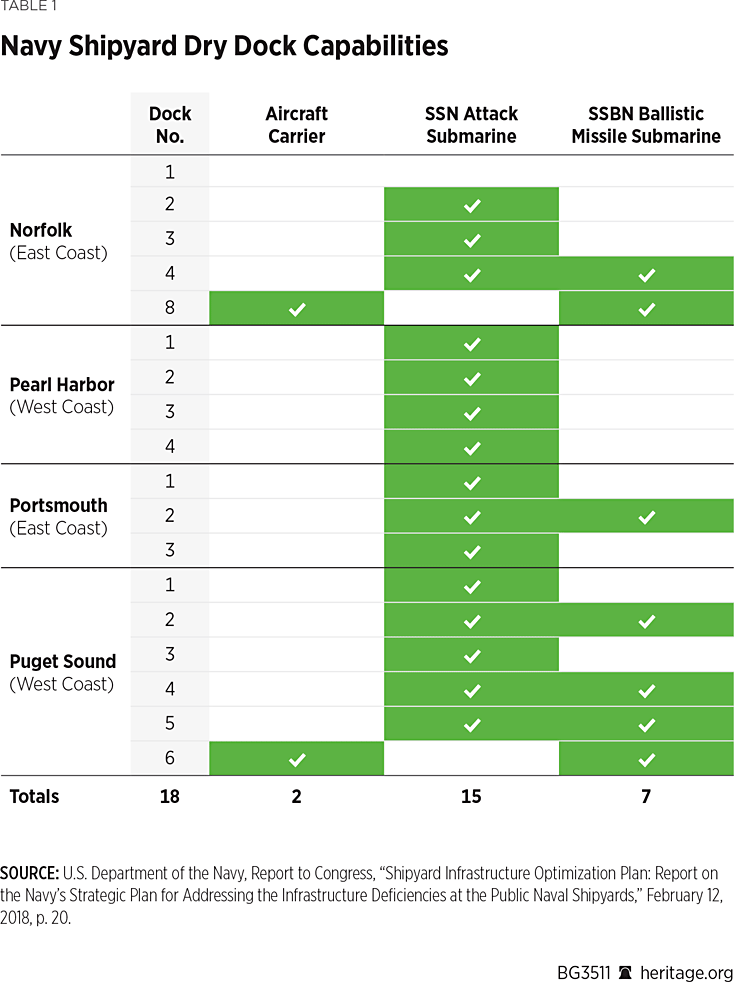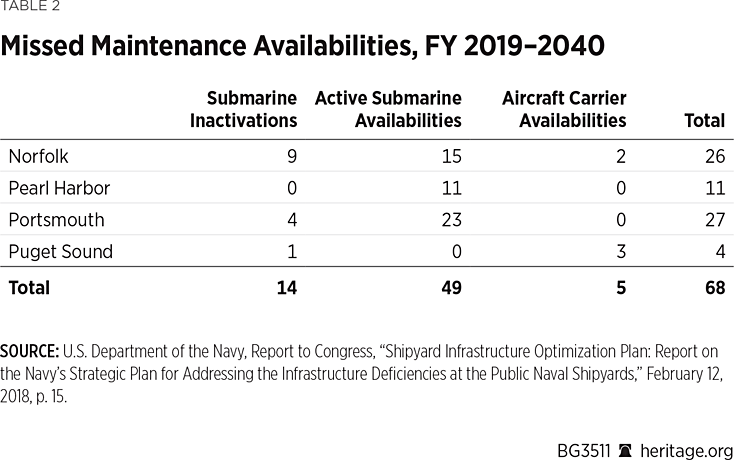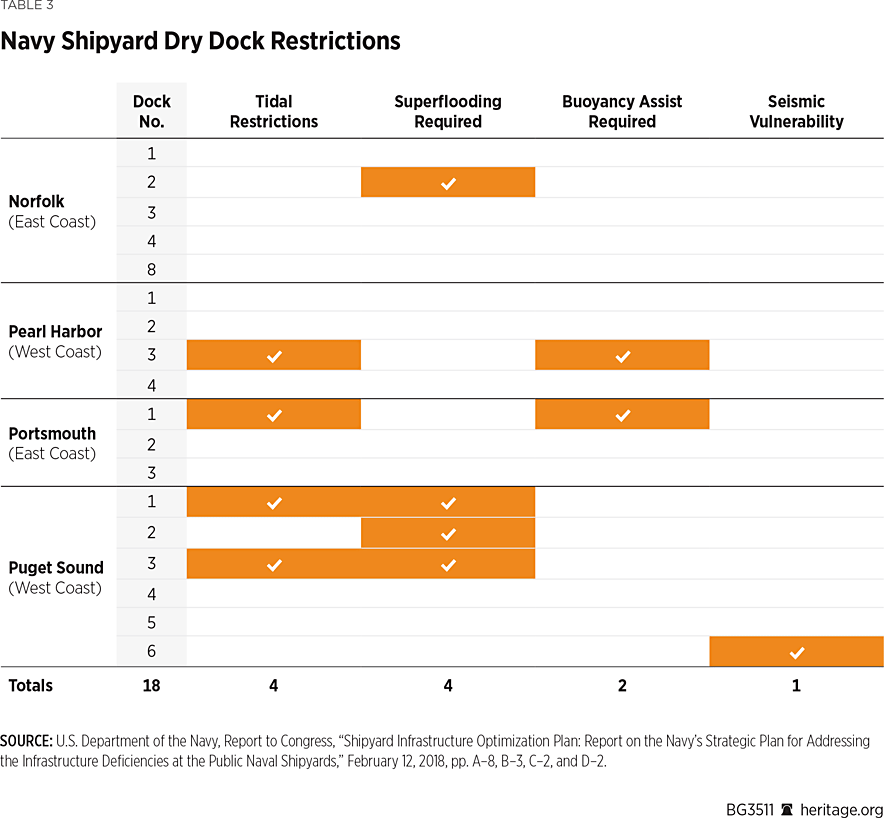The United States is entering a new era of great-power competition, and its dominance of the world’s oceans is now contested. China is rapidly modernizing its military and asserting itself in its regional seas. The U.S. Navy will need to meet this challenge, and it cannot do so without the support of its public shipyards.
The Navy owns and operates four public shipyards: Portsmouth Naval Shipyard in Maine, Norfolk Naval Shipyard in Virginia, Puget Sound Naval Shipyard and Intermediate Maintenance Facility in Washington State, and Pearl Harbor Naval Shipyard and Intermediate Maintenance Facility in Hawaii. Two are on the East Coast, and two are on the West Coast.
These four shipyards are responsible for maintaining the Navy’s nuclear fleet of aircraft carriers and submarines. Approximately 22 private U.S. shipyards perform all other shipbuilding and ship repair for the Navy.REF While private shipyards are a vital part of the Navy’s industrial base, they function differently than Navy shipyards and face their own set of unique challenges. This paper focuses on the four public shipyards.
The four Navy shipyards as they exist today are inadequate to accomplish their assigned mission. They have too few functional dry docks, and their facilities and capital equipment are old and poorly configured. As a result, submarine and carrier maintenance is frequently delayed, resulting in fewer ships available for Navy operations. This adds to the Navy’s shortfall of ships, which is already well below the 355 ships required by law and the 400 recommended by Heritage Foundation experts.REF
The Navy is aware of the situation and responded to these problems in 2018 with a Shipyard Infrastructure Optimization Plan, which outlines solutions to the shipyards’ most glaring problems.
This report provides background on U.S. Navy shipyards and assesses their ability to meet the Navy’s needs. It then analyses the Navy’s Shipyard Infrastructure Optimization Plan and concludes with recommendations for how Congress and executive branch should proceed.
Navy Shipyard History
The United States has owned Navy shipyards since 1799, when Benjamin Stoddert, the first Secretary of the Navy, determined that a U.S. navy would be cheaper to build and maintain in government-owned shipyards than private ones.REF From the 1830s until the turn of the century, the Navy had seven or eight public shipyards in operation at any given time.REF In the first decade of the 20th century, three new shipyards (NSYs) were established, including the still operational Pearl Harbor and Puget Sound NSYs, bringing the total number of public shipyards to nine. (In the early 1900s, Pensacola NSY became an air station.)
This number was constant until World War II, when two more shipyards were established to meet the massive needs of the wartime Navy. These 11 shipyards marked the height of Navy shipyard numbers. Two yards closed in the 1960s, and another in the 1970s, as consensus grew that building new ships in private shipyards was 30 percent to 40 percent more efficient than building them in public shipyards. Navy shipyards stopped building new ships in the late 1950s and early 1960s and shifted to only maintenance work.REF After these shipyard closures, eight were left.

Big changes came in the mid-1990s. In 1988, Congress passed the Base Realignment and Closure Act (BRAC), creating a process to evaluate U.S. military installations for closure. Committees determined which bases, air stations, and other installations were necessary to meet the country’s defense needs.REF Four Navy shipyards were closed as a result: Philadelphia NSY in 1991, Mare Island NSY in California and Charleston NSY in 1993, and Long Beach NSY in 1995.REF According to the BRAC findings, these four yards provided a “considerable excess of shipyard capacity” given the number of ships in the Force Structure Plan, and the Department of Defense successfully made the case that the remaining shipyards could easily absorb these closed yards’ workload.REF In 2005, it was actually proposed that the Navy scale down to only three shipyards by closing Portsmouth Naval Shipyard. Portsmouth was later taken off the list, and four shipyards remain in operation today and are managed by Naval Sea Systems Command.REF
Current Shipyards
An important and relatively straightforward way to quantify shipyard capacity is to count the number of dry docks. A dry dock is a narrow manmade basin, often the approximate shape and size of the ships that will be docked in it. The basin is filled with water to allow a ship to be floated inside, then drained so the ship can be repaired in dry conditions. The four yards have 18 dry docks: eight on the East Coast (three at Portsmouth and five at Norfolk) and 10 on the West Coast (six at Puget Sound and four at Pearl Harbor).

These numbers are easy enough to understand, but understanding the maintenance capacity they provide is more complicated.
First, dry docks are not a piece of equipment, but a piece of infrastructure. In this sense, they are not interchangeable. Each is constructed differently: They vary in depth, length, and width; filling and draining mechanisms; and age—one dry dock at Norfolk was the first constructed in the Western Hemisphere and has been in operation since 1833.REF
As a result, not every dry dock can accommodate every ship. Only two dry docks—Dry Dock 8 at Norfolk and Dry Dock 6 at Puget Sound—can service Nimitz-class carriers. Most dry docks are not large enough to hold an aircraft carrier.REF
The Navy’s attack submarines have also evolved, but the dry docks that service them have not: 17 dry docks can service older Los Angeles-class submarines, but only 12 can accommodate their replacement, the Virginia-class submarine, and only seven can service the newest Block V Virginia-class submarine, which is 83 feet longer than earlier variants and displaces an additional 2,400 tons.REF
Second, some dry docks being used “get the job done” but are not optimally suited to the tasks they perform. For example, four of the Navy’s dry docks must be “superflooded”—filled with water above their designed maximum water levels—to float the submarines they service in and out of the dock.REF This damages electrical equipment and other features of the dry dock that are not meant to be submerged.
No dry dock at any Navy shipyard can accommodate the new Ford-class aircraft carrier, even though the first Ford-class carrier was commissioned in 2017.REF While the current aircraft carrier dry docks are large enough to hold the Ford-class carrier, the docks lack the utility services needed to service the carrier.
Requirements
The composition of the U.S. Navy’s nuclear fleet determines the fleet’s maintenance requirements and thus the Navy shipyards’ workload.
Current Fleet. The U.S. Navy has 80 nuclear-powered ships: 11 aircraft carriers, 51 attack submarines, and 18 ballistic-missile and guided-missile submarines.REF
With each class of ship comes a projected service life, including a planned maintenance schedule made up of maintenance “availabilities,” or planned maintenance periods throughout the ship’s service life. For reference, Nimitz-class carriers have a projected service life of 50 years, which includes four Drydocking Planned Incremental Availabilities (each 16 months) and 12 Planned Incremental Availabilities (each six months).REF It also includes one 44-month midlife Refueling and Complex Overhaul, which is performed at Huntington Ingalls Industries Newport News shipyard, not a Navy shipyard.
Virginia-class submarines have a service life of 33 years.REF The currently deployed Blocks I–III of the Virginia-class are scheduled to have four depot-level maintenance availabilities and 14 deployments. The Block IV Virginia-class submarine is designed to have only three depot-level maintenance availabilities, allowing for 15 deployments in its life cycle.REF The Navy has to schedule maintenance for all 80 nuclear ships, finding the time and space at shipyards for each maintenance availability.
Future Fleet. The exact maintenance requirements of the Navy’s future fleet are changing; after all, the desired size and structure of the future fleet are under revision. The 2020 National Defense Authorization Act made President Trump’s 355-ship Navy official U.S. policy.REF The Navy’s most recent Force Structure Assessment, published in 2016, calls for 90 nuclear-powered ships: 12 aircraft carriers, 66 attack submarines, and 12 ballistic missile submarines.REF However, the Navy is expected to release the new Integrated Naval Force Structure Assessment sometime in 2020, and Navy officials have suggested the new assessment will call for a different fleet architecture, which could entail a different number of nuclear ships.REF
Although there is much debate about the makeup of the 355-ship fleet, nuclear fleet projections typically fluctuate less. Numbers of aircraft carriers and ballistic submarines are likely to remain nearly constant. The number of attack submarines is a bit more variable (e.g., the Navy’s fiscal year (FY) 2021 budget decision to not seek a tenth Block V Virginia-class submarine).REF
Assessment
The capacity, condition, and workforce of the Navy’s shipyards are insufficient to meet the needs of the fleet.
Quantity. The Navy’s four shipyards and 18 dry docks as configured today are insufficient to meet the maintenance needs of the current fleet. The Navy quantified this in its Shipyard Infrastructure Optimization Plan. It found that Navy shipyards will be unable to accommodate 68 of the total maintenance availabilities required between 2019 and 2040.REF These availabilities will include 14 submarine deactivations, 49 active submarine maintenance periods, and five carrier maintenance periods.REF It based its calculations on the current number and condition of dry docks compared to maintenance needs of the nuclear fleet, as it is scheduled to grow in current shipbuilding plans.

Evidence of this abounds. The Government Accountability Office reported that between 2008 and 2018, attack submarines spent a total of 61 months idle while waiting to enter dry docks for depot-level maintenance.REF Between this idle time and depot maintenance delays, the Navy spent approximately $1.5 billion on attack submarines that provided zero operational capability.REF
The poster child of this problem is the USS Boise. The attack submarine was scheduled for an extended maintenance period in 2013, but the maintenance was deferred due to dry-dock unavailability. It had to stop normal operations in 2016 and sat idle for over two years before it was transferred to a private shipyard to begin its overhaul.REF This clearly indicates the Navy needs more shipyard capacity for the nuclear fleet.
Condition. Not only is the quantity insufficient, but the overall condition of Navy shipyards is poor. All four Navy shipyards are over 100 years old—Norfolk Navy Shipyard is more than 250 years old—and their facilities reflect this.REF Combined with underinvestment in past years, this has left the shipyards’ dry docks, facilities, and equipment in critically poor condition. Many dry docks at Navy shipyards are simply too old, too small, and in disrepair.
The Navy knows this. By its own assessment, the average condition rating of shipyard production shop facilities is 66, which is considered poor and falls far below the Navy’s standard of 80.REF

Meanwhile, general shipyard facilities are in poor condition. The existing buildings and warehouses were built and configured based on past shipbuilding methods. And more facilities were added as time went on, resulting in today’s hodge-podge of buildings and facilities without much intention behind their layout.
Just as concerning, capital equipment in Navy shipyards is also in poor condition. Capital equipment at shipyards encompasses a wide variety of items, such as plasma cutters, cranes, furnaces, and sheet-metal rollers.REF Capital equipment in Navy shipyards is an average of 24 years old, while equipment in private yards averages 7–10 years old.REF
Personnel. Another problem is the difficulty of recruiting the skilled workforce necessary to repair the Navy’s nuclear fleet. The electricians, welders, and other skilled workers must be trained to do very specific work—ship repair and overhaul—and must do it to exacting Navy standards.
When the Navy scaled back its fleet in the 1990s and early 2000s in the post–Cold War era, very few new workers were hired. Now the Navy is expanding, and so are its shipyard workforce requirements. Most of the experienced workers of the earlier era have retired, leaving shipyards with few experienced workers to mentor a large number of less-experienced workers: 45 percent of skilled workers at Puget Sound and 30 percent of skilled workers at Portsmouth Naval Shipyards have fewer than five years’ experience.REF Navy ship repair is highly technical, and inexperienced workers who lack supervision are more likely to make mistakes. This can cause significant delays, which ripple across the entire fleet’s maintenance planning.
The Navy’s Plan
The FY 2018 National Defense Authorization Act, via Senate Report 115-125, required the Secretary of the Navy to submit a report to Congress detailing the capacity of the four public shipyards, any potential shortfalls in the near future, and a strategy to meet fleet maintenance requirements. The Navy responded with the Shipyard Infrastructure Optimization Plan (SIOP), a 253-page report in February 2018 that describes the four shipyards’ deficiencies in detail. It then proposes its plan to remedy the problems and increase the yards’ capacity to meet the needs of the nuclear fleet as projected in the 2016 force structure assessment. The plan includes an estimated timeline and cost.
The SIOP is more than a renovation plan for the four shipyards. It is a systems engineering project on a massive scale. Using digital modeling of the shipyards’ workflow and processes, the Navy intends to find the most efficient layout for each shipyard and reconfigure the yards’ facilities and capital equipment based on those findings. The SIOP has its own program office (PMS-555) within the Department of the Navy; it produced the report to Congress and is tasked with overseeing the plan’s implementation.
The SIOP has three categories of improvements: dry-dock improvements, reconfiguration of facilities, and capital improvements.
Dry-Dock Improvements. The SIOP comprehensively evaluates all 18 dry docks in the four shipyards. It finds that renovating eight of the 18 dry docks per the plan recommendations would recover 67 out of 68 anticipated missed availabilities.
The proposed improvements are precisely timed. For example, at Puget Sound Naval Shipyard, Dry Dock 6 is the only Navy shipyard dry dock on the West Coast that can service an aircraft carrier.REF It also is built in a fault zone, and its construction is not properly reinforced, making it vulnerable to seismic activity. Specifically, the earth under the dry dock may be “subject to liquefaction in a seismic event,” i.e., in a significant earthquake, there is a good chance that the dry dock would essentially be sucked into a sinkhole.REF The dry dock needs to be partially rebuilt and reinforced, but before that can happen, Dry Dock 3 needs to be expanded to accommodate aircraft carriers while Dry Dock 6 is under construction. Otherwise, the Navy would have no capability of servicing aircraft carriers on the West Coast while Dry Dock 6 is under construction.REF
Other aspects of the dry-dock improvement plan are similarly exactly timed, accounting for the relative urgency of different projects. The first projects are at Norfolk Naval Shipyard to establish the necessary utilities at Dry Dock 8 to accommodate the Ford-class carriers.REF
All the dry-dock investments were planned for FY 2018–FY 2040. The estimated total cost of the dry-dock projects is $4.178 billion, with $853 million at Norfolk Naval Shipyard, $600 million at Portsmouth Naval Shipyard, $2.16 billion at Puget Sound Naval Shipyard, and $565 million at Pearl Harbor Naval Shipyard.REF
However, issues with the SIOP’s budget estimates are already appearing. In the SIOP, FY 2021 spending on a project at Portsmouth Naval Shipyard was estimated at $381 million. However, the President’s budget request for FY 2021 estimates the costs for the project at $715 million—the amount which is being requested to be authorized.REF It demonstrates potential unreliability in the SIOP’s cost estimates: The $715 million requested is far more than the $381 million estimate. The reliability of SIOP cost estimates is further discussed in a later section.
Reconfiguration of Facilities. As previously stated, all four Navy shipyards are over 100 years old. Their facilities were initially built and configured based on shipbuilding methods of a century ago, and more facilities were added over the years. The result today is a hodgepodge of buildings and facilities without much intention behind their layout. This creates inefficiencies in Navy shipyard operations, which the SIOP parses out and proposes to remedy by modeling and completely reconfiguring the shipyards.
The timeline for completing a facilities reconfiguration is long. The Navy proposes creating detailed virtual models of each shipyard’s facilities operations to better understand where components move within the shipyard between dry docks and buildings.REF Once this digital model is complete, engineers will test different configurations and find the most efficient layout for each shipyard. The time and money required are unknown because they will depend on the results of the modeling and experimentation phase and the actual changes at the shipyard—that is, which buildings need to be torn down and what new buildings need to be constructed. The Navy’s best guess is in the range of $11.7–$14.0 billion, which assumes complete demolition and reconstruction of the shipyards.REF
Capital Improvements. The SIOP also finds that the capital equipment in the Navy shipyards is too old in both lifespan of the equipment and the technology it uses.REF
The solution to this is less complex than the previous issues discussed. The Navy simply listed all the capital equipment needed in the shipyards—over 500 items—in order of priority. The Navy plans to spend $150 million per year for 30 years on capital equipment, for a total of $4.5 billion.REF
Assessment
The Navy’s SIOP proposes a nearly total reconstruction of the four public shipyards, based on the results of complex engineering and experimentation. Such a project has never been seen in military depot maintenance or in the shipbuilding industry. The comprehensive and technologically advanced plan and the institutional support behind it suggest the Navy is thinking critically about the public shipyards’ deficiencies. If the SIOP is implemented fully, it would address all of these deficiencies. However, the plan raises a few concerns.
First, the plan’s cost estimates are unavoidably hazy. The cost estimates fail to incorporate standard factors, such as accounting for inflation.REF A cost estimate in 2018 dollars for a project that will begin in 2033 will not give a good basis for planning. The Government Accountability Office (GAO) expressed this concern in a 2019 report, stating that the Navy did not develop its cost estimates to GAO standards.REF The Navy’s response is that its estimates are only notional and will solidify as phases of the plan are completed. The Navy cannot know the cost of the facilities reconfiguration until it has completed its modeling process and knows how the facilities will be reconfigured. This is true enough, but even though these cost uncertainties cannot be helped, they naturally will make government watchdogs, lawmakers, and the Office of Management and Budget nervous in times of constrained defense spending.
A potential challenge in implementing the SIOP is its reliance on “just-in-time” funding. The plan is very precisely timed: Dry docks are repaired just in time to meet a new wave of scheduled ship availabilities, funding is obtained just in time to perform these dry-dock repairs, the completion of one project allows another to begin, and so forth. If one project goes unfunded in one year or if unexpected construction delays occur, it will have a ripple effect. The case of maintaining an aircraft carrier servicing capability at Puget Sound Naval Shipyard is one example. The Navy addresses this by saying it will need special appropriations with the authority to execute across multiple fiscal years, but the likelihood of Congress granting this seems slim.REF
The SIOP is based on the current nuclear fleet, but it does not quite even meet the requirements of the current fleet. (It would make up for 67 of 68 missed maintenance availabilities, the missed availability being a submarine deactivation.) While this would be a massive improvement for the shipyards, it leaves little margin for unscheduled emergent work and does not allow for a potentially larger or different nuclear fleet in the future.
Ultimately, the SIOP should to be considered in light of what it is: a plan to make the four current Navy shipyards effective in meeting the needs of the current fleet as outlined in the 2016 force structure assessment. It does this in a robust, technologically advanced, and forward-thinking way. But Navy leadership also needs to think critically about the future of Navy shipyards in light of a potentially changing Navy force structure as the U.S. returns to an era of great-power competition.
Recommendations
Accordingly, Heritage Foundation analysts recommend:
- Fully funding the Navy’s SIOP to prevent maintenance delays. For the foreseeable future, the Navy needs its four public shipyards to successfully maintain its fleet on schedule. The SIOP is the best plan to address decades of infrastructure neglect at the four shipyards. The Navy’s shipyard restoration plan represents a relatively small piece of the defense budget, but Navy shipyards have an outsized impact on national defense because they keep the attack submarines, aircraft carriers, and the submarine side of the nuclear triad afloat. Whatever changes may be made, the projects to rebuild the shipyards should be funded.
- Reconsidering the number of Navy shipyards and dry docks. The SIOP is a comprehensive plan to meet current needs of the nuclear fleet with the current four shipyards. But the Navy is bound to change as the U.S. returns to a period of great-power competition, so the Navy leadership needs to consider whether it needs to further expand shipyard capacity. BRAC decisions made in the 1990s, immediately after the end of the Cold War, may not make sense today. Then, the problem was excess capacity, while the problem today is a capacity shortfall. Simply reopening the closed shipyards is impossible because many are privately owned and operated and others no longer exist. Building a new shipyard would be a massive undertaking and may not be feasible. Current shipyards may have no room for additional dry docks or facilities. The Navy should look at these issues and consider whether and when building additional dry docks at current shipyards and/or opening a new shipyard may become necessary.
- Reconsidering the division of labor between public and private shipyards. Currently, private shipyards build the Navy’s nuclear ships, and public shipyards maintain them. This is not a hard and fast rule, though, as demonstrated by the USS Boise, which was moved to Huntington Ingalls Industries Newport News shipyard for its overhaul. The Navy has contracted out some submarine maintenance to both Newport News Shipbuilding and General Dynamics Electric Boat, with mixed results: Both experienced delays and cost overruns.REF However, maintenance work is different from shipbuilding, and private shipyards are not able to take on maintenance work overnight. These issues may smooth themselves out with time and experience. According to the head of Naval Sea Systems Command, Newport News has already made a lot of progress in submarine maintenance and will likely continue to perform Navy submarine maintenance.REF Legally, the Navy cannot spend more than 50 percent of its annual depot-level maintenance and repair funds on services contracted with the private sector, but it has flexibility in how it divides work between public and private shipyards.REF Ultimately, the cost-effectiveness of public versus private shipbuilding and ship maintenance has been a debate since the first public shipyard was founded, and it is a calculus that changes over time. The Navy should consider whether private industry should take a bigger role in nuclear ship maintenance.
Conclusion
As the United States returns to great-power competition, it will rely more heavily on its Navy to defend the nation’s interests and meet its responsibilities around the world. And the Navy needs an effective repair base to keep its ships operational. This repair base may evolve—and Navy leaders should think strategically about its evolution—but for now it requires modernizing and reconfiguring the four existing public shipyards to meet the nuclear fleet’s requirements. Leaders’ choices to prioritize Navy shipyard modernization will have an outsized impact on Navy readiness and on national security as a whole.
Maiya Clark is a Research Assistant in the Center for National Defense, of the Kathryn and Shelby Cullom Davis Institute for National Security and Foreign Policy, at The Heritage Foundation.



